Armour has formed a strong client base of athletes and sport enthusiasts. Fans are loyal and choose the brand over others because they believe in the company mission and the quality of the product. The company has access to many loyal athletes that are used as influential in commercials due to the relationships formed with college and professional athletes. While successful in their performance apparel endeavors, Under Armour has faced a different experience with the original launch of their footwear in 2009, probably because it did not include any of the technology that makes the performance wear so valuable to its fans. With the addition of Under Armour-ESQUE Technology to the shoe designs, this attempt should be a bit more successful, but not everyone is convinced. When evaluating the Q3 2011 financial results, it was realized that many people did not like Under Armour’s footwear strategy and it was predicted that a replica of the 2009 incidence would be experienced.
Table of Contents
- Background Information
- Environmental Scan
- Internal Environment
- SWOT Analysis
- Strengths
- Weaknesses
- Opportunities
- Threats
- The External Environment
- The Industry
Objectives and Key Themes
This document examines the strategic plan of Under Armour, a company specializing in performance apparel and footwear. It analyzes the company's internal and external environments, identifying strengths, weaknesses, opportunities, and threats.
- Market positioning and competition within the athletic apparel and footwear industry
- Environmental analysis, encompassing both internal and external factors
- SWOT analysis to assess Under Armour's strengths, weaknesses, opportunities, and threats
- Strategic considerations for market expansion and product development
- The company's overall strategic plan and its potential for future success
Chapter Summaries
Background Information
This chapter provides an overview of Under Armour's history, founding, and initial product line. It highlights the company's focus on moisture-wicking apparel designed to enhance athletic performance.
Internal Environment
This section delves into Under Armour's target market, encompassing both professional and amateur athletes. It describes the company's product line, which includes a wide range of apparel, footwear, and accessories.
SWOT Analysis
This chapter presents a detailed SWOT analysis of Under Armour, identifying its strengths, weaknesses, opportunities, and threats. Strengths include a loyal customer base, influential brand ambassadors, and a skilled footwear team. Weaknesses include the company's rapid growth rate, potential for high capital commitment, and initial challenges in the footwear market.
The External Environment
This section discusses the external factors affecting Under Armour's business, including the economic climate, competition from Nike, and the overall athletic apparel industry landscape.
The Industry
This chapter provides an overview of the athletic shoe industry, highlighting key competitors such as Adidas and Nike. It examines the growth potential of the athletic apparel market and Under Armour's market share in both performance apparel and footwear.
Keywords
This strategic plan for Under Armour focuses on key themes within the athletic apparel and footwear industry. Key terms include performance apparel, moisture-wicking technology, market share, competitive landscape, SWOT analysis, economic factors, and strategic planning.
- Quote paper
- Hillary Mwendwa (Author), 2011, Strategic Plan of an Athletic Apparel Label: Under Armour, Munich, GRIN Verlag, https://www.grin.com/document/269358




